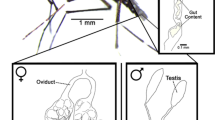Summary
Vector competences ofAedes (Ae.) vexans nipponii (nip.) andCulex (Cx.) tritaeniorhynchus to Getah virus were assessed by using a membrane feeding technique. The Getah virus was present at high titer in both species of mosquitoes after 21 days of extrinsic incubation at 28° C. Infection rates on 21 post-feeding were 100 per cent (4/4) forAe. vexans nip. at a virus dosage of 105.3 PFU/ml and 60 per cent (3/5) forCx. tritaeniorhynchus at similar virus dosage. More than 103.5 PFU of virus was detected in salivary glands of both species of mosquitoes on day 21 of extrinsic incubation. Forty percent (2/5) ofAe. vexans nip. transmitted the virus into serum-agar after ingesting 104.3 PFU/ml of virus blood mixture. In experiments withCx. tritaeniorhynchus ingesting 107.5 PFU/ml of virus blood mixture, 57 per cent (4/7) were able to transmit the virus to suckling mice and 59 per cent (10/17) transmitted the virus into serum-agar.
Similar content being viewed by others
References
Doherty, R. L.: Arboviruses of Australia. Aust. Vet. J.48, 172–180 (1972).
Doherty, R. L., Carley, J. G., Mackerras, M. J., Marks, E. N.: Studies of arthropod-borne virus infections in Queensland. III. Isolation and characterization of virus strains from wild-caught mosquitoes in North Queensland. Austral. J. Exp. Biol.41, 17–40 (1963).
Doherty, R. L., Gorman, B. M., Whitehead, R. H., Carley, J. G.: Studies of arthropod-borne virus infections in Queensland. V. Survey of antibodies to group A arboviruses in man and other animals. Aust. J. Exp. Biol.44, 365–378 (1966).
Grimstad, P. R., Craig, G. B., jr., Ross, Q. E., Yuill, T. M.:Aedes triseriatus and LaCross virus: Geographic variation in vector susceptibility and ability to transmit. Am. J. Trop. Med. Hyg.26, 990–996 (1979).
Gubler, D. J., Nalim, S., Tan, R., Saipan, H., Sulianti Saroso, J.: Variation in susceptibility to oral infection with dengue viruses among geographic strains ofAedes aegypti. Am. J. Trop. Med. Hyg.28, 1045–1052 (1979).
Kamada, M., Ando, Y., Fukunaga, T., Kumanomido, T., Imagawa, H., Wada, R., Akiyama, Y.: Equine Getah virus infection: Isolation of the virus from racehorses during an enzootic in Japan. Am. J. Trop. Med. Hyg.29, 984–988 (1980).
Matsuyama, T., Nakamura, T., Isahai, K., Oya, A., Kobayashi, M.: Haruna virus, a group A arbovirus isolated from swine in Japan. Gunma J. Med. Sci.16, 131–134 (1967).
Matsuyama, T., Oya, A., Ogata, T., Kobayashi, I., Nakamura, T., Takahashi, M., Kitaoka, M.: Isolation of arboviruses from mosquitoes collected at live-stock pens in Gunma Prefectures in 1959. Jap. J. Med. Sci. Biol.13, 191–198 (1960).
Sanderson, C. J.: A serological survey of Queensland cattle for evidence of arbovirus infection. Am. J. Trop. Med. Hyg.18, 433–439 (1969).
Scherer, W. F., Funkenbush, M., Buescher, E. L., Izumi, T.: Sagiyama virus, A new group A arthropod-borne virus from Japan. I. Isolation, immunologic classification and ecologic observation. Am. J. Trop. Med. Hyg.11, 255–268, (1962).
Scherer, W. F., Izumi, T., McCown, J., Hardy, J. L.: Sagiyama virus. II. Some biological, physical, chemical and immunologic properties. Am. J. Trop. Med. Hyg.11, 269–282 (1962).
Sentsui, H., Kono, Y.: An epidemic of Getah virus infection among racehorses: Isolation of the virus. Res. Vet. Sci.29, 157–161 (1980).
Shichijo, A., Mifune, K., Chin, C. C., Hayashi, K., Wada, Y., Ito, S., Oda, T., Omori, M., Suenaga, O., Miyagi, I.: Isolation of Japanese encephalitis virus and group A arboviruses fromAedes vexans niponii caught in Nagasaki area, Japan. Trop. Med.12, 91–97 (1970).
Simpson, D. I. H., Way, H. J., Platt, G. S., Bowen, E. T. W., Hill, M. W., Kamath, S., Bendell, P. J. E., Heathcote, O. H. U.: Arbovirus infections in Sarawak, October 1968–February 1970: Getah virus isolations from mosquitoes. Trans. R. Soc. Trop. Med. Hyg.69, 35–38 (1970).
Takahashi, M.: The effects of environmental and physiological conditions ofCulex tritaeniorhynchus on the pattern of transmission of Japanese encephalitis virus. J. Med. Ent.13, 275–284 (1976).
Takahashi, M.: Variation in susceptibility among coloney strains ofCulex tritaeniorhynchus to Japanese encephalitis virus infection. Jap. J. Med. Sci. Biol.33, 321–329 (1980).
Tesh, R. B., Gajdusek, D. C., Garruto, R. M., Cross, J. H., Rosen, L.: The distribution and prevalence of group A arbovirus neutralizing antibodies among human populations in Southeast Asia and the Pacific Islands. Am. J. Trop. Med. Hyg.24, 664–678 (1975).
Yamamoto, H.: Arbovirus infections in the mosquitoes of Fukuoka area, Kyushu, Japan. 2. Natural infection of mosquitoes with the viruses of Getah complex in the period from 1963–1972. Jap. J. Sanit. Zool.31, 23–30 (1980).
Author information
Authors and Affiliations
Rights and permissions
About this article
Cite this article
Takashima, I., Hashimoto, N., Arikawa, J. et al. Getah virus inAedes vexans nipponii andCulex tritaeniorhynchus: Vector susceptibility and ability to transmit. Archives of Virology 76, 299–305 (1983). https://doi.org/10.1007/BF01311197
Received:
Accepted:
Issue Date:
DOI: https://doi.org/10.1007/BF01311197




